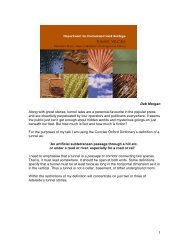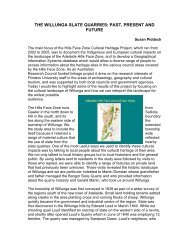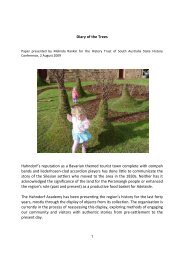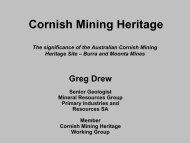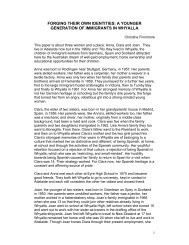The McTaggarts; stories of a pastoral dynasty - History SA
The McTaggarts; stories of a pastoral dynasty - History SA
The McTaggarts; stories of a pastoral dynasty - History SA
You also want an ePaper? Increase the reach of your titles
YUMPU automatically turns print PDFs into web optimized ePapers that Google loves.
<strong>The</strong> <strong>McTaggarts</strong>; <strong>stories</strong> <strong>of</strong> a <strong>pastoral</strong> <strong>dynasty</strong><br />
Invitation to write the book<br />
Ruth Anderson<br />
‘I want you to write our story’, said the man sitting next to me at the <strong>pastoral</strong><br />
ball. Too much wine I thought. He asked me again a few weeks later, as<br />
though he were simply asking me to write a letter. He was serious. I knew<br />
that years ago a journalist had attempted the task and given up. I wanted to<br />
do it with all my heart, but I didn’t want to give up half way through and we all<br />
know that families can be tricky when it comes to which side <strong>of</strong> the story one<br />
tells. Could I be factual without fall out, could I delve and poke and pry and<br />
print it all without prejudice?<br />
This man Malcolm McTaggart wanted me to chronicle the lives <strong>of</strong> five<br />
generations <strong>of</strong> his McTaggart family. I knew that he had been President <strong>of</strong> the<br />
Stockowners Association and chairman <strong>of</strong> the Meat and Wool section, and<br />
was on the Soil Advisory Board and many other bodies, but I didn’t know him<br />
personally.<br />
I lived on Cooyerdoo Station at the time and the <strong>McTaggarts</strong> flagship<br />
property, Nonning, lay across Lake Gilles from us. I didn’t really know much<br />
about them at all, but <strong>of</strong> course the funny thing was I ended up knowing far<br />
more about them than they knew about themselves.<br />
Once I said I’d accept the challenge my life changed. I began an adventure<br />
that took me on the most fascinating historical journey <strong>of</strong> discovery,<br />
crisscrossing the world, entering wars, witnessing weddings, droughts,<br />
different cultures, (Aboriginal, Chinese and Afghan to name a few). In this<br />
world I travelled by many modes <strong>of</strong> transport from oxen and dray, camel<br />
buggies, horseback, pushbikes, motorbikes, light aircraft, steam engines and<br />
cruise ships. I learned about shooting horses in the drought and cueing oxen<br />
in the bush.<br />
I met most members <strong>of</strong> this <strong>pastoral</strong> family, each telling me their story, and<br />
<strong>of</strong>ten their secrets - their side <strong>of</strong> the story. Sometimes too, during my<br />
research, I learned secrets from beyond the grave, sweet and sometimes sad<br />
snippets <strong>of</strong> information, unrecorded in the family history, which I never can<br />
tell.<br />
Piled up on my kitchen table I had Bishops and boundary riders, stockmen,<br />
<strong>pastoral</strong> inspectors, publicans, politicians, poetry and photographs.<br />
<strong>The</strong> many generations <strong>of</strong> the McTaggart family were all there too in neatly<br />
segregated piles in chronological order, whether or not they happened to be<br />
speaking to each other at the time.<br />
Imagine my horror though, when one windy day, my husband opened the<br />
kitchen door and a gust <strong>of</strong> wind scattered my piles every which way.<br />
“Look what you’ve done now,” I screamed, “<strong>The</strong> Bishop <strong>of</strong> Willochra has<br />
ended up on top <strong>of</strong> Mrs McTaggart.”<br />
Malcolm McTaggart, who commissioned me to write the book, supported and<br />
encouraged me, made his records and photographs available to me, and<br />
1
<strong>of</strong>ten pointed me in the right direction when I became lost. Sometimes I was<br />
even in the wrong generation. Using the same Christian names was helpful<br />
for tracing families, but a trial sometimes to slot them in their respective<br />
generation.<br />
Malcolm’s wife Pam, acted as cook and butler at the family lunches, and how I<br />
laugh now at my first faux pas. I remember handing her the very special bag<br />
<strong>of</strong> Darrel Lea chocolates to serve with c<strong>of</strong>fee after lunch, but I was horrified to<br />
see her <strong>of</strong>fering the silver platter around the dining room table at Blarentibert<br />
with tiny boiled lollies, the lollies intended for my young grandchildren. I’d<br />
given her the wrong bag. How my grandchildren would have been enjoying<br />
the Darrel Lea chocolates.<br />
<strong>The</strong> family lunches were a great social gathering and a chance to meet all <strong>of</strong><br />
the characters about whose family I was writing, but it wasn’t a great success<br />
in getting one clear story, because <strong>of</strong> course each person had their own side<br />
<strong>of</strong> the story, their own opinion about a person, their own memory.<br />
People were slow to <strong>of</strong>fer anything about them selves in writing, so I went<br />
home and wrote a vague representation <strong>of</strong> what I thought they had meant.<br />
“Oh no,” they proclaimed, “that’s not how it was, this is how it happened.”<br />
<strong>The</strong>y came in like the tide. Family members rang me, some came to see me,<br />
and others invited me into their homes.<br />
Gradually over two and a half years the story knitted together with the editing<br />
skills and wonderful wit <strong>of</strong> Dr Peter Linklater, a great grandson <strong>of</strong> John and<br />
Mary McTaggart.<br />
First Pioneers<br />
Over 150 years ago a young man called John McTaggart attended a<br />
Highlands and Islands Emigration Society meeting and what he heard here<br />
encouraged him to leave the small family cr<strong>of</strong>t called Blarentibert in<br />
Argyllshire in Scotland to seek his fortune in Australia. He joined many others<br />
at this time, excited about the political promise <strong>of</strong> being able to rent vast areas<br />
<strong>of</strong> land in Australia compared to the family’s small unpr<strong>of</strong>itable cr<strong>of</strong>t, and<br />
boarded the sailing vessel Bengal Merchant for a wearisome five-month<br />
journey to Australia.<br />
Today there’s a stately home sentimentally called Blarentibert, on Robe<br />
Terrace in North Adelaide, where the <strong>McTaggarts</strong> who commissioned me to<br />
write the book live. My quest was simply to fill in the 150 years between<br />
Blarentiberts.<br />
Three months after arrival in the new country John McTaggart met and<br />
married Mary McCallum, whose Uncle in the south east <strong>of</strong> South Australia<br />
helped them to fatten a flock <strong>of</strong> sheep, which John McTaggart walked to<br />
Adelaide to sell. <strong>The</strong> pr<strong>of</strong>it on this deal enticed him and his brother in law John<br />
McCallum to come north and take up unsettled land near Lake Frome, which<br />
he named Wooltana.<br />
Mary’s journey.<br />
2
A year later Mary and their young family <strong>of</strong> four were sent for. <strong>The</strong>y travelled<br />
by steamship to Port Augusta and then by bullock dray for the month long<br />
journey over rough unmade tracks to Wooltana. On her ninetieth birthday,<br />
Mary remembered this trip, saying, ‘It was a slow journey but we were all<br />
young and happy and quite enjoyed the experience, even if we had to battle<br />
along, it was no worse than all early settlers in any land so why grumble and<br />
make it worse.’<br />
At Wooltana there was only a rough slab hut to welcome her, and Mary and<br />
John <strong>McTaggarts</strong> nearest neighbors were at Arkaba, 140 miles south. It was<br />
here with constant fear <strong>of</strong> native attack that Mary raised her family <strong>of</strong> 10<br />
children. Mary <strong>of</strong>ten used her home-made primitive medicines to nurse the<br />
men who were speared by natives, but later the hand <strong>of</strong> friendship was<br />
<strong>of</strong>fered and the natives said <strong>of</strong> John McTaggart, ‘that he was a fair man for he<br />
fought with a waddy and not a firearm’ and the natives came to quite like the<br />
white children, the flour-bag piccaninnies.<br />
Carting the Wool from Wooltana<br />
John McTaggart took the wool to Port Augusta by dray and oxen to be loaded<br />
<strong>of</strong>f the roughly made wooden jetty onto the ships that waited there. Broken<br />
dray wheels, lame bullocks and fear <strong>of</strong> native attack were John’s constant<br />
companions on that month long trip.<br />
On one trip John lost all his bullocks to pleuro-pneumonia and had to leave<br />
his dray and all the station supplies on the edge <strong>of</strong> the track and walk home.<br />
Usually upon arrival at the Port, John enjoyed the invitation on board the<br />
sailing ships by the captain to hear news <strong>of</strong> the outside world, and indeed the<br />
seamen were equally as interested to hear from the <strong>pastoral</strong>ists about how<br />
the new country was being opened up. An acquaintance with Captain Begg <strong>of</strong><br />
the Pakwan was a friendship that was later rekindled when John’s son<br />
Lachlan visited the old captain in England.<br />
An historical highlight <strong>of</strong> the years at Wooltana was the visit <strong>of</strong> the McKinlay<br />
expedition who stayed overnight on their way north to search for the fated<br />
Burke and Wills explorers.<br />
John and Mary lost 4000 sheep in the disastrous droughts <strong>of</strong> the 1860’s,<br />
when the sheep were, according to a witness at a Pastoral Commission at<br />
that time, ‘like lanterns and scratched up the stones with their poor tongues to<br />
eat the fibres out <strong>of</strong> the ground as there was nothing else for them.’ <strong>The</strong>n<br />
when the rains did come they lost sheep in the wet after shearing because<br />
they were so poor.<br />
<strong>The</strong> <strong>McTaggarts</strong> saw some <strong>of</strong> their neighbors walk <strong>of</strong>f their leases, but they<br />
held on and recovered to reap good wool prices in the 1870’s enabling them<br />
to purchase a retirement property in the Adelaide Hills called Forest Lodge,<br />
leaving their eldest son Lachlan McTaggart on Wooltana.<br />
3
Lachlan <strong>McTaggarts</strong> wife had been the former Miss Murray whose family had<br />
owned the Coromandel Valley biscuit and jam factory and farmed that fertile<br />
valley and bred stud rams there.<br />
When I traveled to Adelaide and asked at the Mortlock Library for any<br />
McTaggart files, they searched to no avail, but when I mentioned the name<br />
Murray I had a huge surprise, for this time the archivists surfaced with a trolley<br />
laden with boxes. ‘Which are mine?’ I asked. ‘All <strong>of</strong> them,’ the archivists<br />
replied.<br />
What I discovered that afternoon in the reading room <strong>of</strong> the Mortlock Library in<br />
1995 I will never forget. I found diaries, letters, journals, cards and recipes as<br />
well as old photographs that chronicled the business and personal lives <strong>of</strong><br />
those early pioneers. Boxes and boxes <strong>of</strong> what was mainly McTaggart history.<br />
<strong>The</strong>re were photographs <strong>of</strong> huge teams <strong>of</strong> donkeys carting the wool with four<br />
baby donkeys lying down asleep, and a small aboriginal boy atop the load. In<br />
another they all were wool washing at Parallana with the ladies looking on in<br />
long dresses and tied bonnets.<br />
I cried out loudly when I opened one journal for there was the old pioneering<br />
John <strong>McTaggarts</strong> handwriting. I looked around the Reading Room but my<br />
glance was met with smiles, for the other readers understood my joy <strong>of</strong><br />
discovery.<br />
How much simpler my task would have been had these papers been listed<br />
under the names McTaggart / Murray instead <strong>of</strong> only Murray.<br />
<strong>The</strong>re were photographs <strong>of</strong> many healthy happy aboriginal children among<br />
the family groups - and I was upset upon returning at a later time to discover<br />
they had been removed. I felt somehow cheated for I believed that they<br />
belonged to these archives. Politics aside, this was their place at that time in<br />
the <strong>pastoral</strong> history <strong>of</strong> this state. <strong>The</strong> aboriginal families played an important,<br />
valued role, which was always acknowledged by the <strong>McTaggarts</strong>.<br />
When I staggered out into the North Terrace sunshine I half expected to see<br />
long gowns and horse drawn carriages, and I wondered where Frogmore<br />
House was, where ‘our dear Bella died at 4 o’clock today.’ I also wondered<br />
where the beautiful retirement property, Forest Lodge had been. I drove<br />
dreamily to my daughter’s cottage in the Adelaide Hills not feeling quite in this<br />
century.<br />
I showed my daughter some letters I had been given, written by a man, Ge<strong>of</strong>f<br />
Nicolle, who worked for old man McTaggart, one hundred years before at the<br />
place called Forest Lodge. My daughter looked at me strangely and took me<br />
outside. Along the road she lifted the ivy from the pillars <strong>of</strong> the big house next<br />
door and smiled. <strong>The</strong> sign said, Forest Lodge. This house, where my<br />
daughter had been married, was the place where old John and Mary<br />
McTaggart had their photographs taken with their family in 1908. My<br />
daughter lived in the little cottage, the Lodge <strong>of</strong> Forest Lodge, and I was<br />
sleeping in the front bedroom where this old man who wrote the letters had<br />
been born.<br />
4
This was the place where the retired <strong>McTaggarts</strong>, away from the harsh<br />
northern climate, grew potatoes, asparagus and gooseberries and where<br />
there was a little thatched dairy set into the bank where the milk separator<br />
was kept, and there was a beautiful English style garden and yabbies in the<br />
creek. <strong>The</strong>re was a pine tree a mere metre high behind the photograph <strong>of</strong> old<br />
Mary and her grandchildren in 1900. I looked at it now as it soared above the<br />
house. My skin prickled, I felt as though I was walking on McTaggart graves.<br />
This day had been the most unbelievable, the most satisfying day <strong>of</strong> my<br />
journey <strong>of</strong> discovery.<br />
I went to bed that night and dreamed <strong>of</strong> that bygone era and the man who had<br />
been born in that room on August 13 th 1892 and I saw his granny waving the<br />
sheet to give news that a baby had been born to his father working over on<br />
Fern Hill.<br />
<strong>The</strong> <strong>McTaggarts</strong> <strong>of</strong> Nonning.<br />
J.D. and Ruth<br />
When John and Mary’s only other surviving son, John Donald, or J.D. as he<br />
became to be known, worked on Yudnapinna Station he fell in love with the<br />
managers daughter and when he moved to Carriewerloo a young aboriginal<br />
boy, Harry Dare, acted as the go between carrying love letters from Ruth to<br />
J.D. who waited at the Carriewerloo fenceline.<br />
After their marriage, Ruth and J.D. McTaggart took up the lease <strong>of</strong> Nonning<br />
Station in the Gawler Ranges where they planned to breed excellent sheep.<br />
<strong>The</strong>y were well equipped to handle the harsh life for they knew too well about<br />
droughts; they had seen the rotting carcasses and empty waterholes, but they<br />
also knew the providence <strong>of</strong> good seasons and great wool clips.<br />
Harry Dare, the go between, was taken to Nonning because as Ruth jokingly<br />
said, ‘Harry is part <strong>of</strong> my dowry.’ When their first child Ian Richard, or I.R. as<br />
he was known, was born in 1900, Harry was entrusted with the job <strong>of</strong><br />
watching over this baby, the precious son and future heir <strong>of</strong> Nonning. Harry<br />
told friends that he was the buggy boy for he pushed the baby’s pram up and<br />
down the verandah <strong>of</strong> the homestead. ‘I aint no ordinary blackfella,’ he said<br />
proudly.<br />
J.D.’s first muster on Nonning was <strong>of</strong> 500 sheep with only one horse, but he<br />
engaged the services <strong>of</strong> Elias Cr<strong>of</strong>t and his family who mustered on foot. <strong>The</strong><br />
Cr<strong>of</strong>ts were a loyal hardworking mixture <strong>of</strong> c<strong>of</strong>fee and white and were<br />
cherished as the most extraordinary Bushmen.<br />
J.D. and Ruth McTaggart had ten children, but two babies, Ruth and Jessie<br />
died each aged five months, and when Ruth became ill a young station hand<br />
voluntarily cycled over rough tracks to Port Augusta overnight arriving back at<br />
Nonning at breakfast with the precious medicine for Mrs Ruth McTaggart.<br />
J.D. McTaggart was a tall man <strong>of</strong> at least 16 stone with an outgoing<br />
personality, who commanded respect from all who knew him. J.D. worked<br />
5
tirelessly to develop Nonning and the conformation and constitution <strong>of</strong> his<br />
sheep as well as the quality and density <strong>of</strong> the wool. Moonaree was added to<br />
their <strong>pastoral</strong> holdings and some land at Wilmington. In 1923 the company<br />
carried a total <strong>of</strong> 33,000 sheep.<br />
On Sundays the Sabbath was observed and the minister travelled from Iron<br />
Knob, <strong>of</strong>ten by pushbike, over forty miles <strong>of</strong> torturous tracks. Sewing and<br />
knitting were not permitted on Sundays, but fancy work was, and after tea the<br />
dining room was cleared and a musical evening held. On weeknights cards<br />
were played and young Gwen said when her luck was out she found that<br />
sitting on her handkerchief or walking around the table once would <strong>of</strong>ten<br />
change her luck. Cricket and billiards were also favorite pastimes and <strong>of</strong><br />
course the <strong>McTaggarts</strong> bred beautiful horses for stock work and polo. Cricket<br />
matches were held and teams came from Whyalla, Port Augusta and Iron<br />
Knob to challenge the <strong>pastoral</strong>ists and the feature <strong>of</strong> the day was a splendid<br />
lunch supplied by the McTaggart ladies.<br />
<strong>The</strong> homestead garden was developed and Ruth enjoyed the services <strong>of</strong> a<br />
Chinese gardener, Harry Ying, who the children remembered for growing the<br />
most beautiful watermelons.<br />
I.R. and Gwen<br />
When J.D. and Ruth retired to Adelaide to live, Ian. R. McTaggart or I.R. as he<br />
was known, took over as the managing director <strong>of</strong> the Nonning Pastoral<br />
Company in 1937, which that year had shorn 49,000 sheep on the 3<br />
properties.<br />
Although I.R. was required to ride horses, camels and mules, and not by<br />
choice, he said, his great passion was engines and the advent <strong>of</strong> flying. I.R.<br />
had several plane crashes, the first while he was still receiving instructions,<br />
and the second at Modbury when his plane spun out <strong>of</strong> control and crashed in<br />
pieces in a paddock. I.R. and his flying <strong>of</strong>ficer were unceremoniously<br />
transported to hospital in a woodcarters cart. I.R.’s only injury from this horrific<br />
crash was a broken ankle which was to plague him all <strong>of</strong> his life, but against<br />
all advice he would not give up flying.<br />
I.R. bought his first plane in 1946, a Moth Minor, and thus continued a flying<br />
career that took him all over Australia on business and pleasure and many<br />
adventures - most the family would rather forget. He finally lost his pilot’s<br />
license at the grand age <strong>of</strong> 83.<br />
I.R. developed the properties with the aid <strong>of</strong> his brothers, Lachlan, Donald and<br />
Archie. <strong>The</strong>y built dams, fenced paddocks and generally improved the quality<br />
<strong>of</strong> their sheep. <strong>The</strong>y had pr<strong>of</strong>essional financial advisors and money from<br />
good years was invested wisely, allowing the family’s holdings to develop and<br />
expand into Western Australia.<br />
Second World War<br />
6
Donald and Lachlan went away proudly to the Second War. While flying low<br />
looking for anti-aircraft tanks in Egypt Lachlan’s plane was hit and burst into<br />
flames. Lachlan bailed out and he landed in the desert. He never saw any <strong>of</strong><br />
his crew again and he walked 70 miles under cover <strong>of</strong> darkness until on the<br />
third morning was luckily picked up by an air-sea rescue crew.<br />
Later he was given time <strong>of</strong>f in Cairo where he met up with his brother Donald,<br />
and other South Australians Peter Bowman, Keith McBride and Ian Marshall.<br />
In Cairo they enjoyed ‘four glorious days.’ Sadly Peter and Keith were killed<br />
shortly after this ordeal, but the McTaggart boys returned home physically<br />
unscathed.<br />
One photograph sent to Lachlan many years after the war which had been<br />
found with Peter Bowmans possessions, was <strong>of</strong> Lachlan on the day he was<br />
picked up in the desert, and on the back in Peter Bowman’s, writing, ‘Lockie<br />
the day we picked him up from the desert.’<br />
Lachlan believed that his ability to survive his desert ordeal was due to his<br />
bush knowledge that he had learned in the station country around Nonning.<br />
Back at Nonning during the Second World War the women found themselves<br />
doing jobs that the men usually undertook and it was a time when visitors<br />
were not made as welcome because there simply wasn’t time to cook and<br />
entertain with all the stock work to be done.<br />
I.R. McTaggart married Gwen Bayly, whose father was headmaster <strong>of</strong> Prince<br />
Alfred College. Life at Nonning was a cultural shock for the city girl and at first<br />
staff took advantage <strong>of</strong> her inexperience, but the young bride soon learned<br />
the ropes and entertained many people including Lord Althorpe, later Earl<br />
Spencer, who later became father to Princess Diana.<br />
I.R. and Gwen had four children at Nonning, Alan, Mary, Heather and<br />
Malcolm. Alan managed the Nonning Pastoral Company’s Mundabullangana<br />
Station in Western Australia, but died at the Port Hedland airstrip whilst<br />
waiting to be airlifted to hospital in Perth. He left a wife and 10-month-old<br />
daughter.<br />
Arthur Whyte<br />
Gwen addressed all the male staff by their surnames with the exception <strong>of</strong><br />
Arthur Whyte, whom she particularly liked and admired. Arthur arrived at<br />
Moonaree as a 16 year old in 1937, boots polished, riding Bertha and leading<br />
Toby, with his swag rolled and saddle bags neatly packed. Arthur went away<br />
to war to battle Rommel and although he said he experienced some very dark<br />
moments he came home safely, only to lose an arm in a pit in a freak<br />
ammunition exercise. He remembers he stood ankle deep in his own blood.<br />
He also remembers the sweet morphine that ended the pain and the next day<br />
they sawed his arm <strong>of</strong>f.<br />
Arthur didn’t let his disability thwart his lifestyle in any way, he still rode and<br />
shod his horses and climbed windmills. He later entered politics and became<br />
President <strong>of</strong> the Legislative Council in South Australia.<br />
7
Arthur Whyte kindly wrote the foreword to the book, <strong>The</strong> McTaggart Story,<br />
and his photograph riding Amy the camel graces page three <strong>of</strong> the book.<br />
Arthur told <strong>stories</strong> about Bill Holt who worked for the <strong>McTaggarts</strong> at<br />
Moonaree, an interesting forthright person who was over six feet tall, the last<br />
<strong>of</strong> the Kokatha tribe with any authority, who took his knowledge to the grave<br />
lest it fall into the wrong hands. Bill Holt is buried at Iron Knob.<br />
I.R. and Gwen <strong>McTaggarts</strong>’ story at Nonning is a long and interesting one, but<br />
when their time was finished they decided to have their ashes buried atop the<br />
hill behind the homestead at Nonning in those granite Gawler Ranges. From<br />
this vantage point they can survey the homestead and all the buildings and <strong>of</strong><br />
course the work continuing below.<br />
Summing up<br />
<strong>The</strong> McTaggart story, only a portion <strong>of</strong> which has been recalled here, has<br />
been one <strong>of</strong> triumphs and tragedies, hardships and survival, <strong>of</strong> great loves<br />
and strong loyalties. John McTaggart, the patriarch <strong>of</strong> this family, would be<br />
proud <strong>of</strong> his successors who have multiplied, diversified and prospered - with<br />
the help <strong>of</strong> all those shepherds and shearers, teamsters, station hands,<br />
spiritual advisors, financial advisors and tradesmen.<br />
Over 100 years ago Nonning employed 1 man for every 1000 sheep and a<br />
small community developed, bookkeepers, boundary riders, cooks,<br />
governesses, and station hands, gardeners. However today, only 5 men are<br />
employed at Nonning, and the ratio is 1 man to every 5000 sheep.<br />
<strong>The</strong> present manager, Angus McTaggart, who is the son <strong>of</strong> Malcolm and<br />
Pam, and grandson <strong>of</strong> I.R. McTaggart, says he thinks that history is being<br />
made on Nonning right now in 2005 with one <strong>of</strong> the worst droughts on record.<br />
Angus though, comes from tough pioneering stock, like those before him no<br />
doubt he will survive to reap the benefits <strong>of</strong> good seasons and better wool<br />
prices.<br />
Bibliography <strong>The</strong> McTaggart Story<br />
Author Ruth Anderson 1995<br />
Open Book Publisher<br />
8



